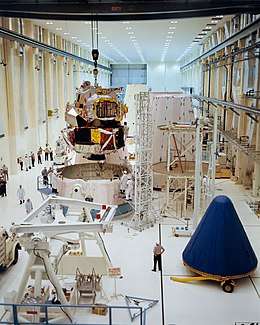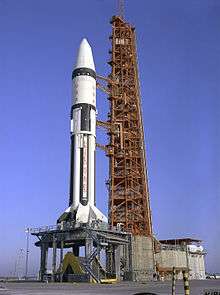Apollo 5
Apollo 5 (also known as AS-204), was the first uncrewed flight of the Apollo Lunar Module (LM), which would later carry astronauts to the lunar surface. It lifted off on January 22, 1968, with a Saturn IB rocket on an Earth-orbital flight.
 Lunar Module 1 being mated to the Spacecraft–LM adapter (SLA) in preparation for launch as Apollo 5 | |
| Mission type | Uncrewed Earth orbital LM flight (B) |
|---|---|
| Operator | NASA |
| COSPAR ID | Ascent stage: 1968-007A Descent stage: 1968-007B |
| SATCAT no. | 3106 |
| Mission duration | 11 hours, 10 minutes |
| Orbits completed | 7 |
| Spacecraft properties | |
| Spacecraft | Apollo Lunar Module-1 |
| Manufacturer | Grumman |
| Launch mass | 14,360 kilograms (31,660 lb)[1] |
| Start of mission | |
| Launch date | January 22, 1968, 22:48:09 UTC |
| Rocket | Saturn IB SA-204 |
| Launch site | Cape Kennedy LC-37B |
| End of mission | |
| Disposal | Uncontrolled reentry |
| Deactivated | January 23, 1968 9:58 UTC |
| Decay date | Ascent stage: January 24, 1968 Descent stage: February 12, 1968 |
| Orbital parameters | |
| Reference system | Geocentric |
| Regime | Low Earth orbit |
| Perigee altitude | 167 kilometers (90 nmi)[1] |
| Apogee altitude | 222 kilometers (120 nmi)[1] |
| Inclination | 31.63 degrees[1] |
| Period | 88.4 minutes[1] |
| Epoch | January 22, 1968[2] |
 | |
Objectives
The Apollo 5 mission tested the lunar module in a space environment, in particular its descent and ascent engine systems, and its ability to separate the ascent and descent stages. The descent engine would become the first throttleable rocket engine fired in space.
The mission also performed a simulation of a landing abort, in which the ascent stage engine would be fired while still attached to the descent stage. This, referred to by engineers as the "fire in the hole" test, was depicted in the mission's insignia patch.
Delays
As with Apollo 4, this flight experienced long delays. The primary cause of this was the lunar module, which was well behind schedule. Some of the delay could be attributed to lack of experience in building a crewed spacecraft to land on the Moon.
The first uncrewed launch was originally planned in April 1967, requiring delivery at the Cape around September 1966. But delays kept occurring. Although the lunar module was fully designed, there was trouble fabricating the custom-made parts. The engines were also having problems. The descent engine was not burning smoothly, and the ascent engine was having fabrication and welding difficulties.
In the end, these problems were overcome, but it took several months and it was not until June 23, 1967, that LM-1 arrived at the Cape on board Aero Spacelines' Super Guppy. After four months of tests and repair, the LM was mated to the launch vehicle on November 19.
On December 17, 1967, another LM under test failed in the Grumman Aircraft Engineering Corporation ascent stage manufacturing plant. A window in LM-5 (Apollo 11's LM Eagle) shattered during its initial cabin pressurization test, designed to pressurize the cabin to 5.7 pounds per square inch (39 kiloPascals) above the external pressure. Both inner and outer windows and the acrylic glass cover of the right-hand window shattered when the pressure reached 5.1 pounds per square inch (5.1 35 kPa).
On December 28, 1967, a decision was made to replace the glass windows in LM-1 with aluminum plates as a precaution against a failure in flight similar to the one that occurred on LM-5 in testing.
Flight

The launch vehicle for Apollo 5 was the Saturn IB, a smaller rocket than the Saturn V, but capable of launching an Apollo spacecraft into Earth orbit. The Saturn IB SA-204 used on Apollo 5 was the one originally intended for Apollo 1.[3] It had been undamaged in the fire at Launch Complex 34 and was reassembled at Launch Complex 37B for the Apollo 5 launch.
The windows of LM-1 were replaced before the flight with solid aluminum plates. To hasten delivery, it was decided to do without the lunar module's legs. Without a crew or command and service module (CSM), there was no need for a launch escape system. As a consequence, the assembled rocket was 180 feet (55 m) tall, compared to the usual CSM stack height of 223 feet (68 m).
On January 22, 1968, Apollo 5 lifted off just before sunset. The Saturn IB worked perfectly, inserting the second stage and LM into a 88-by-120-nautical-mile (163 by 222 km) orbit.[1] The nose cone was jettisoned, and after a coast of 43 minutes 52 seconds, the LM separated from its adapter, in a 90-by-120-nautical-mile (167 by 222 km) orbit.[1] After two orbits, the first planned 39-second descent-engine burn was started, but aborted by the Apollo Guidance Computer after only 4 seconds. Shortly before launch there was a suspected fuel leak, and a decision was made to delay arming the engine until the time of ignition.[4] This change had increased the time required for the propellant tanks to pressurize and thrust to build to the required level. NASA didn't communicate this change to the AGC programmers. This led to the AGC not measuring any thrust within the predefined time and aborted the maneuver.
The ground controllers moved to an alternate plan to fire the descent engine manually two more times. They then performed the "fire in the hole" test and another ascent-engine burn.
After 11 hours 10 minutes the test was over, and control of the two stages was terminated. The stages were left in a low enough orbit that atmospheric drag would soon cause their orbits to decay and re-enter the atmosphere. The ascent stage (1968-007A) re-entered on January 24 and burned up; the descent stage (1968-007B) re-entered on February 12, falling into the Pacific several hundred kilometers southwest of Guam.[5]
Despite the trouble during the descent-engine burn, NASA deemed the mission a success in demonstrating the LM systems, and a second uncrewed flight test using LM-2 was canceled. LM-3 was cleared for the first crewed LM flight, which occurred on Apollo 9.
Insignia
This patch was not designed by NASA but by the engineers at Grumman who designed and built the lunar module. It portrays the fire-in-the-hole test. It also shows the LM without landing gear and with the Moon on the right.
References
![]()
- "Apollo 5". NASA Space Science Data Coordinated Archive. Retrieved September 26, 2016.
- McDowell, Jonathan. "SATCAT". Jonathan's Space Pages. Retrieved March 23, 2014.
- "Apollo Program". National Air and Space Museum. Bellcomm, Inc Technical Library Collection. Washington, D.C.: Smithsonian Institution. 2001. Subseries III.D.3. Accession No. XXXX-0093. Retrieved July 8, 2013.
- Eyles, Don (February 6, 2004), "Tales From The Lunar Module Guidance Computer", 27th annual Guidance and Control Conference, Breckenridge, Colorado: American Astronautical Society
- Evans, Ben (2010). Escaping the Bonds of Earth: The Fifties and the Sixties. Springer. p. 435. ISBN 9780387790930.
External links
- Moonport: A History of Apollo Launch Facilities and Operations (1978) by Charles D. Benson and William Barnaby Faherty, The NASA History Series, NASA SP-4204
- Chariots for Apollo: A History of Manned Lunar Spacecraft (1979) by Courtney G. Brooks, James M. Grimwood and Loyd S. Swenson, Jr., The NASA History Series, NASA SP-4205
- U.S. Registry of Objects Launched into Outer Space

